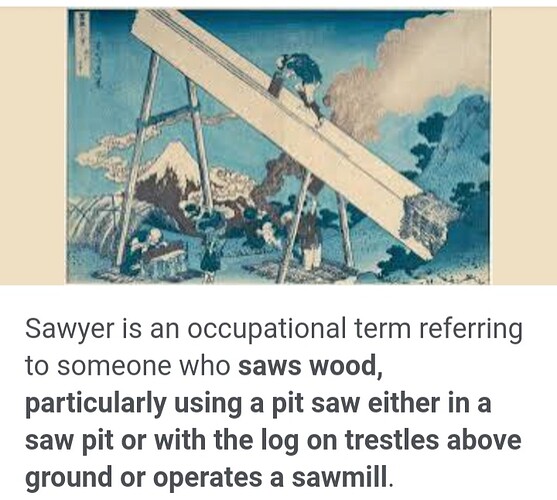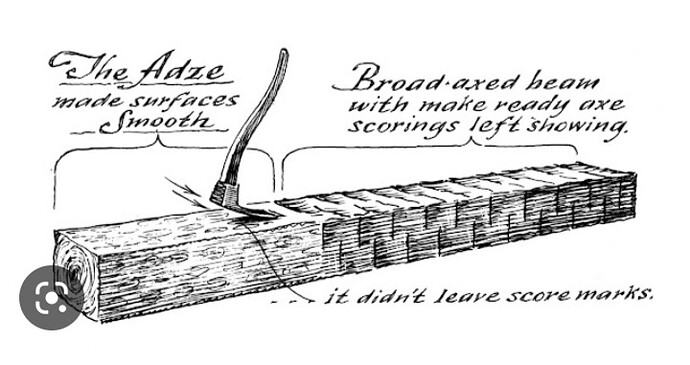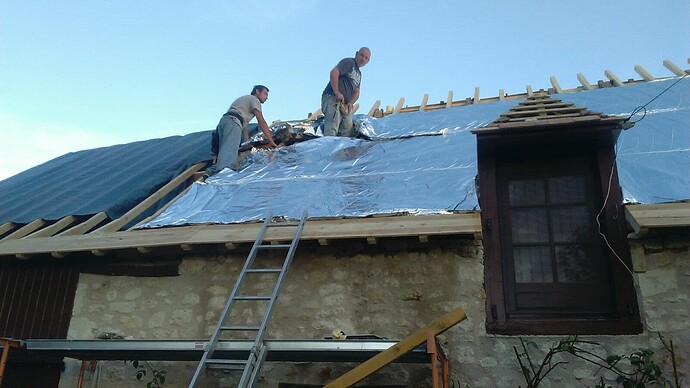Age the gaps arrive as the wood dries out.
This was just a sample photo off Google - but as @SuePJ points out - look at the wobbly boards.
We had roofing membrane laid over the Volige - I suppose it does mean that the appearance from within is traditional.
When we bought our house eleven years ago, it had a recently renewed roof (tile), but the previous 'wobbly boards had been retained. These had been cut with an adze so should predate the huge C18th water-powered saws used for floorboards etc (fearsome machines when in action!). They might even be original like the rest bar one of the roof timbers (C14th). It’s amazing how long wood can last down in the south.
By contrast in Central Africa few wooden artefacts last more than forty years due to the climate and burrowing insects. Consequently most of the ‘authentic’ ie. pre-1940 non-metallic-cultural products that have survived are found in private Western anthropological museums or private collections. Still a little mentioned factor in restitution debates
Eyesight not that bad yet ![]() yes, saw the wobbly boards clearly in the pic. Maybe my question should have been why have they used those ‘wobbly boards’ that give such large gaps???
yes, saw the wobbly boards clearly in the pic. Maybe my question should have been why have they used those ‘wobbly boards’ that give such large gaps???
When we lived in the Aude they just did them like that, with gaps. When we redid that roof we butted them up.
The trade of sawyer pre dates machinery for cutting boards with one sawyer stood in a pit and his mate on top. The adze was used to shape beams and the like. A good adzeman could shape anything.
Round here it’s voligeage! But I guess a mumbled word with a v and a g will be understood through france.
Thanks,
I’d seen a waterpowered saw in operation and knew there were earlier hand powed ones, around in some parts of the world,
Don’t read the following if easily upset!
Rare Footage and Stories of Old-Time Lumberjacks Felling Giant Redwoods (thevintagenews.com)
The poster concludes, ’ the historic footage is here to also remind us of an era that was vital to the development of the American West.’
But I’m not sure what was ‘vital’ about it and going further back, don’t know when the two man saw replaced thse adze.
3 rows of volige at the bottom, the rest is multifoil and rockwool internally. Counter battend and breather membrane on top before the tile batten and tiles.
We have a roof area of about 300m2 - the tiles are roughly 100 years old and on their last legs. We secured a fixed quote with a down payment at the end of 2021 which also secured the materials, which was a stroke of good fortune. The work was supposed to happen in October 2022, but got delayed because we wanted to include insulation and that was being done by a separate company.
We went with a professional French company with a good reputation, who were able to well advise and ensure we had the right tiles for both the house and area in which we live. The prices are good (relatively speaking), but it was still eye watering, however since we secured the quote the tile factories have been shutting down kilns, being sold off to foreign buyers and raising prices due to the cost of electricity - I believe roof tiles alone have gone up 40%. The roofer also said (early in 2022) that the price of zinc had doubled (we’re using it for the flashing and guttering). I suspect if we got a quote in 2023 it would be significantly more expensive.
Thank you everyone that has replied
I have worked in the construction industry in the UK for 15 years so have a good grasp of many trades, sadly roofing isn’t one of them although I will have transferable skills
Our main reason for wanting this done is to make the buildings watertight as currently a missing tile means a leak!
The main house is 400m2 and the barn we want to do is another 200m2
To those who did it themselves can you please give me any more information you may think is useful
I definitely believe quality can be achieved cheaply and would definitely be more satisfied if I was to complete the roof myself (with help)
Also the lower part of the roof has Lauzes tiles that we would like to retain if possible.
Does anyone have any knowledge of this type of stone tile and how easy it is to re-fit
Thanks again
They are teardrop shaped , heavy and very irregular, generally held in place with 1 or 2 nails (which is why you have volige on the roof). It would probably be fairly easy to have the lower part in lauze with ardoise above.
Its a lot of roof though, get yourself a good nail gun
Not trying to sound condesending, but you tube is a mine of information, you can teach yourself anything DIY there, if I’m not sure about something I look on there.
There is a fantastic Grand Designs on there about an older retired couple of schoolteachers who had done no DIY and bought a ruin in the Creuse, the total renovated of what was just 4 walls into a stunning bed & breakfast, they learnt everything from videos on you tube, making stairs, roofing, putting joists up & flooring in, plumbing, tiling, plastering everything.
It was a stunning achievement and has always been a source of inspiration to me, I visited Chez Jallot years ago and Deni and Doug were still as enthusiastic as ever.
With your background it won’t be hard just plan ahead and methodically take your time, planning is everything.
Have a look and see ![]()
I remember watching that episode, it was a stand-out one and quite am inspirational one to me.
It reminds me of my neighbour who was never taught DIY, but in his later 60’s, until today (now into his 70’s), transformed his entire house (an old one) all from his own labour by reading books and watching videos. He’s beautifully plastered some of the walls, done all the flooring, new doorways, new bathroom, stairs, terraced his entire garden (it’s on quite a steep slope), and redone the roofing. He transformed his old family childhood home which was a wreck, into something quite beautiful.
The best episode for me, totally amazing determined dogged can do attitude from them, nothing phased them, even when he fell of the ladders putting the beams up ![]()
![]()
Not too far from us and I’ve met them a few times (amazing how television can make a finished room corner look good when the rest is a building site) over the years. They sold up a while ago now and hopefully having a much less stressful lifestyle.
Even in my younger years I couldn’t have taken something like that on myself never mind at their age ![]()
Our village houses have very shallow pitched tiled roofs, but a lot of nearby ones on the Aveyron / Cantal border have steeply pitched lauzes roofs that use wooden pegs rather than nails.
Looks great! Can you tell me the name of the tiles you used please.


